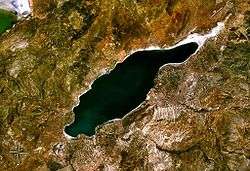Lake Burdur
| Lake Burdur | |
|---|---|
 from space | |
| Coordinates | 37°45′N 30°11′E / 37.75°N 30.18°ECoordinates: 37°45′N 30°11′E / 37.75°N 30.18°E |
| Type | saline |
| Basin countries | Turkey |
| Surface area | 250.00 km² |
| Max. depth | 110 m |
| Surface elevation | 845 m [1] |
| Settlements | Burdur |
| References | [1] |
| Designated | July 13, 1994 [2] |
Lake Burdur (Turkish: Burdur Gölü) is a large saline lake of tectonic origin, positioned at the frontier between Burdur and Isparta provinces, in southwestern Turkey. It is located at around 37°45′N 30°11′E / 37.75°N 30.18°E. It has an area of 250.00 km² and maximum depth variously reported at between 50 and 110 m. Water level in the lake fluctuates. Lake Burdur is also an important wetland site for many bird species and is designated a Ramsar site.
Lake Burdur is among the largest and deepest lakes of Turkey, located at the Lake District Region in south-western Anatolia (37°43′351′′ N, 30°10′878′′ E), within a closed basin. Catchment area is 6150 km2. The average depth is 40 m and maximum depth 68 m. Maximum surface area is 140 km2 at 854 m elevation. It is salty and highly alkaline (pH 9.5) and it never freezes.
Lake Burdur is one of the deepest lakes of Turkey. The aquatic plants are not observed in the lake because of the amount of sodium sulphate and chlorine content. Since the lake does not freeze in winter, it serves as a winter refuge for the birds. The ecosystem of the lake is threatened by the presence of an industrial complex and an airport close to the northern shore. The decrease of water levels (because of construction of upstream dams and unknown causes), increasing of sedimentation (from catchment erosion), organic pollution (from food processing and Burdur City raw sewage waste) and inorganic effluent (from a sulphur mine) represent long-term threats to the integrity of the lake. The water level has decreased from 1975 to 2002 due to construction of dams and ponds in catchment basin, resulting in the loss of 27% of the lake area during the period of 27 years. Nowadays the estimated lake area ranges between 140 km2 or 153 km2. Lake Burdur has great ornithological importance harbouring numerous wintering bird species. It is the most important wintering site in the world for the white-headed duck, a globally threatened species. It has also served habitats to 10 other internationally important waterfowl species. Lake Burdur has been a Ramsar Site since 1993 and Wildlife Reserve since 1994. Aphanius anatoliae sureyanus (the only fish species) and A. burduricus are endemic species of the lake.
The formation of the lake began 5 million years ago as a tectonic depression.(Burdur area is in first grade earthquake zone) It is known that the lake maintained fresh water character for long period of time. The altitude in Plio-pleistocene period was 100 m higher, so the lake extended in NE–SW direction. In late Pleistocene period salinization and shrinking of the lake began, which is a process in progress today. Since 1975 an altitude change of −10 m and 27% volume loss has been recorded. The main reasons for this figures are dams and ponds constructed on main sources of the lake, like Bozcay stream, the severe drought between 1988 and 1995 and especially extensive use of aquifers by local farmers.
References
- Notes
- 1 2 Hammer, Ulrich Theodore (1986), Saline Lake Ecosystems of the World, Springer, ISBN 90-6193-535-0
- ↑ "Ramsar List". Ramsar.org. Retrieved 13 April 2013.
- Sources